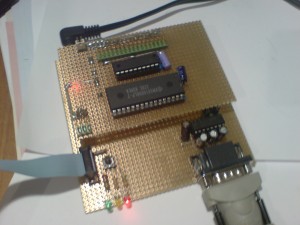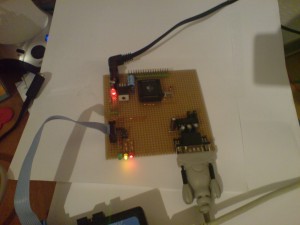The Atmega8515 features a external memory interface that can be used to interface a external SRAM memory. The picture shows my Atmega8515 board with the
addon SRAM board. The small IC is a 74HC537 8-bit latch. The big one is a 128kByte SRAM memory. Only 64bit out of these can be addressed by the microcontroller. One thing that i found worth to notice is: The SRAM has two chip select inputs. The first is /CS1 and the second is CS2. The aim is to use one select signal (without inverter) to distinguish between two memories. I thought it is enougth to use one of the inputs and let the second floating. This was a mistake that caused me some hours of hunting a failure of sporadic instabilities during memory access. ;) The memory access is only valid if /CS1 is low and CS2 is high. I should read the datasheet before next time.
At the moment the whole application runs with a 12MHz crystal and without inserting wait-cycles during memory access. Hence i have a 74AC537 high speed latch i will try to go to 18.432MHz again. Above 14MHz it should be necessary to insert a wait cycle for read and write since the memory latency becomes to large. If one needs the speed he might use a cache memory instead.
Monthly Archives: January 2009
Atmega 8515 at 18MHz…
I assembled a small board containing a Atmega8515 microcontroller. I used a 18.432MHz crystal for clock generation. I discovered that the circuit is very sensitive in terms of routing the ground in a correct way and keeping the crystal connections as short as possible. Now it seems to work more or less stable. The board you can see is similar to the Atmega boards a german company sells as kit. But since these boards do not support the Mega8515 and i want to use its external memory bus feature i had to create a new one…


